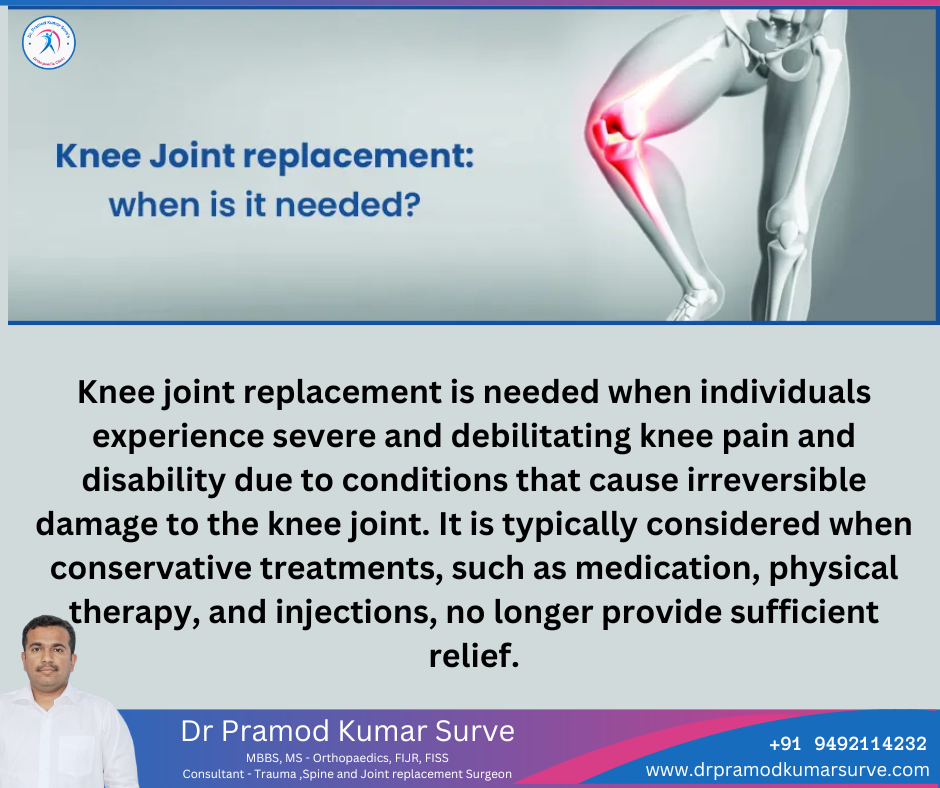Knee joint replacement is needed when individuals experience severe and debilitating knee pain and disability due to conditions that cause irreversible damage to the knee joint. It is typically considered when conservative treatments, such as medication, physical therapy, and injections, no longer provide sufficient relief.
Common conditions that may necessitate knee joint replacement include:
- Osteoarthritis:The most common reason for knee replacement, osteoarthritis is a degenerative joint disease that causes the cartilage in the knee joint to wear away, resulting in pain, stiffness, and reduced mobility.
- Rheumatoid Arthritis:An autoimmune disease that causes inflammation and damage to the joint tissues, including the knee, leading to pain and joint deformities. Post-Traumatic Arthritis occurs after a severe knee injury, such as a fracture or ligament tear, which can lead to accelerated joint degeneration and chronic pain over time
- Knee Deformities:Certain congenital or acquired knee deformities may lead to uneven pressure distribution within the joint, causing progressive joint damage and necessitating joint replacement.
- Avascular Necrosis:This condition occurs when the blood supply to the bone is disrupted, causing bone death and, eventually, joint damage
Knee joint replacement surgery is considered when the pain and functional limitations significantly impact an individual’s daily activities and quality of life, and other treatment options have been exhausted. The decision for knee replacement is made in collaboration with an orthopaedic surgeon, who assesses the patient’s medical history, physical examination, imaging studies, and overall health to determine if the procedure is appropriate for their specific condition.
Causes:
Knee joint replacement is typically needed when the knee joint experiences severe damage or degeneration due to various conditions, including:
- Osteoarthritis: The most common cause of knee joint replacement, osteoarthritis is a degenerative condition where the cartilage cushioning the knee joint wears away over time, leading to pain, stiffness, and reduced mobility.
- Rheumatoid Arthritis: An autoimmune disease that causes inflammation in the synovial lining of the joint, leading to pain, swelling, and joint damage
- Post-Traumatic Arthritis:Following a severe knee injury, such as fractures or ligament tears, the joint may become susceptible to accelerated degeneration and arthritis.
- Knee Deformities:Certain congenital or acquired knee deformities can cause uneven weight distribution within the joint, leading to progressive joint damage.
- Avascular Necrosis:A condition where the blood supply to the bone is disrupted, leading to bone death and joint deterioration.
Symptoms:
The symptoms that may indicate the need for knee joint replacement include:
- Persistent Knee Pain:Chronic and unrelenting pain in the knee, especially during movement or weight-bearing activities.
- Limited Mobility:Difficulty bending or straightening the knee, leading to reduced range of motion.
- Stiffness:Feeling stiffness and tightness in the knee joint, particularly after inactivity
- Swelling: Persistent swelling around the knee joint, often accompanied by warmth and tenderness.
- Functional Limitations:Difficulty performing daily activities, such as walking, climbing stairs, or getting up from a chair.
Treatment:
The treatment for knee joint replacement involves a surgical intervention to replace the damaged joint surfaces with artificial components (prosthetics). There are two main types of knee common replacement surgeries:
- Total Knee Replacement (TKR): In a TKR, the femoral and tibial components of the knee joint are replaced with prosthetic implants. The back of the patella (kneecap) may also be resurfaced with a plastic button.
- Partial Knee Replacement (PKR): In a PKR, only the affected part of the knee joint is replaced with prosthetic components, preserving the healthy portions of the joint.
Following knee joint replacement surgery, a comprehensive rehabilitation program is crucial to facilitate recovery and restore knee function. Physical therapy helps improve strength, flexibility, and mobility while minimizing postoperative complications.
Conclusion:
Knee joint replacement is needed when individuals experience severe and debilitating knee pain and functional limitations due to osteoarthritis, rheumatoid arthritis, post-traumatic arthritis, knee deformities, or avascular necrosis. Conservative treatments may become ineffective in providing relief, and the decision for knee joint replacement is made in consultation with an orthopaedic surgeon.
Persistent knee pain, limited mobility, stiffness, swelling, and difficulty performing daily activities are common indications for knee joint replacement. The surgical procedure involves replacing damaged joint surfaces with prosthetic components to restore joint function and alleviate pain.
Knee joint replacement is a highly successful procedure that has transformed the lives of countless individuals, enabling them to regain mobility and improve their overall quality of life. Patients must work closely with their healthcare team, undergo appropriate rehabilitation, and adhere to postoperative guidelines for a successful recovery.
By addressing the underlying causes of knee pain and opting for knee joint replacement when necessary, individuals can find relief from their debilitating symptoms and return to an active and fulfilling lifestyle. The decision to undergo knee joint replacement should be well-informed and carefully considered to ensure the best possible outcome and a pain-free future.
